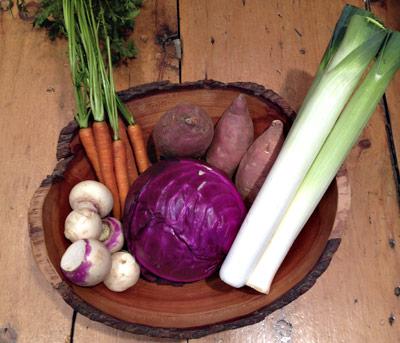Seasons by the Sea: Warming Up to Winter Veggies

When you go through the grocery store this time of year, do you just walk by the odder, wintry vegetables and head for the simpler, “safer,” more familiar ones like zucchini, lettuce, string beans, and so on? I am guilty of this, too. It is so easy to just grab those people-pleasers. You can do anything with zucchini year round, and who doesn’t like green beans with shallots or toasted almonds?
I implore you to try some of these bulbous creatures like kohrabi and rutabagas. Give cabbage a chance; it’s not just Granny’s malodorous boiled glop anymore. Turnips and parsnips are excellent in a roasted vegetable dish. Leeks, while somewhat expensive (considering how much of the stalk you can use), are one of the finest and sweetest alliums, once braised or baked or added to soup. Sweet potatoes and butternut squash are so delicious and good for you, and, contrary to popular belief, don’t need to be peeled for many dishes. Broccoli and cauliflower are in season right now, therefore quite reasonable. Don’t think you like broccoli? Try it raw in a salad with golden raisins, toasted sunflower seeds, and red onion, as Produce Pete suggested recently on the “Today” show. Granted, his were bound with mayo and topped with crisp bacon, but . . . it’s a start.
To find the most modern and creative ways to prepare these vegetables, you may need to update your cookbook collection. Books such as Deborah Madison’s “Vegetable Literacy,” Jeanne Kelley’s “Salad for Supper,” or any of my idol, Yotam Ottolenghi’s, books will inspire you. How does Indonesian slaw with cabbage, scallions, pineapple, and carrots in a peanut dressing sound? Cabbage and kohlrabi in a lemony garlic dressing studded with dried cherries? Baked slices of sweet potatoes in chipotle cream? Of course, some of the old-fashioned recipes are delicious too, such as sweet and sour cabbage, cauliflower gratin, and vichyssoise.
The cabbage family isn’t just broccoli, brussels sprouts, and cauliflower. It also includes mustards and kale, radishes and cress, Asian greens and turnips. Cabbage, which is low in calories and can be eaten cooked or raw, is a good source of vitamins K and C and glutamine. Mustard greens are endowed with vitamins A, C, K, and E. They also have calcium, fiber, manganese, anti-oxidants, and phytonutrients that are said to help prevent cancer and help detoxify the body. Most of us have already jumped on the kale bandwagon, but I must admit I have tried some salads that made me feel like Elsie the Cow chewing my cud forever and ever. Here’s the trick: Shred it finely, then macerate with lemon juice, garlic, olive oil, and salt. Give it a good massage, it will tenderize. Not to mention keep for several days, unlike other dressed salads. If you like it cooked with bacon but that’s too fatty, try it with sautéed onions and smoked paprika. All the flavor without the porcine naughtiness!
The smaller turnips you find in summer are better and sweeter than those you find this time of year, but winter’s offerings are still deliciously sweet and nutty-flavored. You can also use the leaves, whose spicy hot flavor contrasts nicely with the milder root. I like to peel them, slice thinly, and sauté in good butter with a finish of sea salt and chopped chives.
I am skipping rutabagas and parsnips because I don’t care for them and it’s my column. On to the morning glory family, sweet potatoes! This tuber is full of beta-carotene, vitamins A, C, and B6, manganese, calcium, potassium, iron, and fiber. Don’t confuse sweet potatoes with yams, which are bigger, pale, and starchy, tasting more like chestnuts. Sweet potatoes have pointy ends with reddish brown and reddish orange to purply or copper-colored skins. Candied yams are not yams, nor are Garnet or Jewel sweet potatoes, although they are labeled as yams at the market. I like to bake them (cut one of the pointy ends off first and lay on foil) and serve with Greek yogurt and scallions. My vivid imagination tells me this is better than sour cream and butter. They are also delicious sliced and baked with garlic and sage leaves, then topped with a bit of heavy cream for the last half-hour of baking.
As we eagerly await the delicate and wonderful vegetables of spring and summer, I hope these ideas have inspired you to give these wintry wonders a chance. They are healthy, abundant, reasonable, and delicious.
Click for recipes
